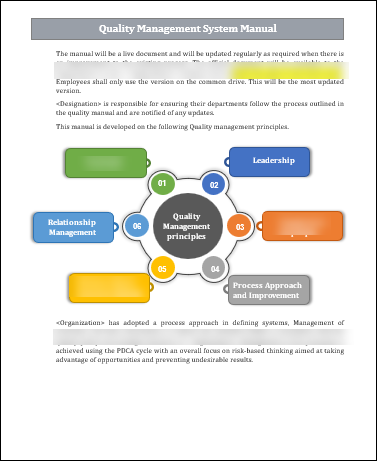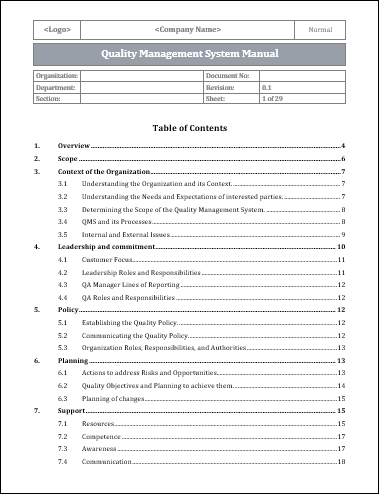ISO 9001 Quality Management System Manual Template
The ISO 9001 Quality Management System (QMS) Manual Template is an essential tool for organizations seeking to implement and maintain a quality management system that meets the requirements of the ISO 9001 standard. This template serves as a comprehensive guide, providing a framework for the development of a QMS that focuses on customer satisfaction, continuous improvement, and consistency in meeting customer requirements. By using this template, organizations can streamline their QMS implementation process and ensure consistency in their approach to quality management.
Importance of ISO 9001 Quality Management System Manual Template
- Standardization: An ISO 9001 Quality Management System (QMS) Manual Template helps organizations establish a standardized system for managing quality across different departments and processes. It provides a framework that ensures consistency in the implementation of quality policies, procedures, and practices.
- Compliance: ISO 9001 is an internationally recognized standard for quality management. By using a QMS Manual Template, organizations can ensure that their quality management system meets the requirements specified in the ISO 9001 standard. This helps in achieving and maintaining compliance with industry regulations and customer expectations.
- Documentation: The QMS Manual Template provides a structured approach for documenting procedures, work instructions, and quality records. This documentation is essential for capturing information related to the organization's quality management system, including processes, responsibilities, and performance indicators. Having a well-documented system enhances transparency and facilitates effective communication within the organization.
- Continuous Improvement: An ISO 9001 QMS Manual Template sets a foundation for continuous improvement. It encourages organizations to identify areas for improvement, establish performance objectives, and monitor progress towards achieving these objectives. Through key quality indicators, organizations can track their performance and take corrective actions when necessary, leading to ongoing improvement in their processes and overall quality.
- Customer Satisfaction: Implementing a QMS based on ISO 9001 helps organizations focus on meeting customer requirements and enhancing customer satisfaction. The systematic approach provided by the QMS Manual Template ensures that customer needs are identified, translated into specific quality requirements, and met consistently. By consistently meeting customer expectations, organizations can enhance their reputation, gain customer loyalty, and increase their competitiveness in the market.
- Risk Management: The QMS Manual Template incorporates risk-based thinking, a key element of ISO 9001, into an organization's quality management system. By identifying and addressing potential risks and opportunities, organizations can improve their ability to prevent quality issues and enhance their ability to seize new business opportunities. This proactive approach to risk management helps organizations minimize quality failures, reduce costs, and improve overall business performance.
Key Components of ISO 9001 Quality Management System Manual Template
- Quality policy: Quality policy: This component outlines the organization's overall quality objectives and commitments. It defines the organization's approach to quality management and sets the tone for the rest of the manual.
- Scope of the Quality Management System: This section defines the boundaries and applicability of the quality management system within the organization. It specifies which processes and activities are included in the system and outlines any exclusions or special considerations.
- Operation: This component focuses on the day-to-day operational processes and activities of the organization. It provides guidance on how to carry out these activities in a manner that aligns with the quality management system's requirements.
- Leadership: This section emphasizes the importance of leadership in promoting a quality culture within the organization. It outlines the responsibilities of top management in ensuring the effectiveness of the quality management system and their role in driving continuous improvement.
- Planning: This component addresses the strategic planning and goal-setting aspects of the quality management system. It outlines the processes for setting quality objectives, developing action plans, and monitoring progress towards achieving them.
- Evidence-Based Decision Making: This section emphasizes the importance of using data, information, and evidence to make informed decisions. It outlines the processes for collecting, analyzing and interpreting data to support decision-making and drive improvements.
- Relationship Management: This component focuses on managing relationships with stakeholders, including customers, suppliers, and other relevant parties. It outlines strategies for understanding their needs and expectations, and for maintaining effective communication and collaboration.
- Process Approach and Improvement: This section highlights the importance of adopting a process approach to quality management. It outlines the processes for identifying, mapping, and managing key processes within the organization, as well as for continuously improving their effectiveness and efficiency.
- Engagement of People: This component emphasizes the importance of involving and empowering employees at all levels in the quality management system. It outlines strategies for fostering a culture of engagement, providing training and development opportunities, and recognizing and rewarding performance.

The Benefits of ISO 9001 Quality Management System Manual Template
The ISO 9001 Quality Management System Manual Template provides a structured framework for companies to set up and maintain a quality management system. Here are some benefits of using this template:- Time-saving: The template provides a pre-designed framework that can be easily customized to suit the company's requirements. This saves time as the organization does not have to start from scratch and can focus on implementing the system more quickly.
- Improved documentation: The manual template ensures that all the necessary documentation is included in the quality management system. This helps companies in effectively documenting and organizing their processes, procedures, and policies, leading to better clarity and understanding of the system.
- Compliance with ISO 9001: The template is designed to align with the requirements of ISO 9001, an internationally recognized standard for quality management systems. By using this template, organizations can ensure that they are compliant with these standards, which can enhance their credibility and reputation in the market.
- Consistency and standardization: The template helps organizations maintain consistency and standardization in their quality management system across different departments and functions. This ensures that everyone in the organization follows the same procedures and practices, resulting in improved efficiency and effectiveness.
- Facilitates continuous improvement: The template promotes the implementation of a continuous improvement culture within the organization. It includes provisions for identifying, monitoring, and evaluating performance indicators, as well as corrective and preventive actions. This enables companies to identify areas for improvement and take proactive measures to enhance their quality standards.
- Enhanced customer satisfaction: By implementing a comprehensive quality management system using this template, organizations can enhance customer satisfaction. The focus on meeting customer requirements and continuously improving processes ensures that the products or services delivered consistently meet or exceed customer expectations.
- Training and guidance: The template provides a clear roadmap for implementing the quality management system. It includes instructions, guidelines, and examples that can serve as a training and reference tool for employees involved in the implementation process. This helps educate and guide the employees, ensuring a smooth implementation.
Conclusion
In conclusion, the ISO 9001 Quality Management System Manual Template serves as a valuable tool for organizations seeking to establish and maintain a high level of quality in their operations. With its comprehensive and systematic approach, this template ensures that all necessary components of a quality management system are addressed and documented.


